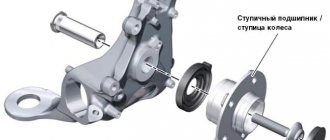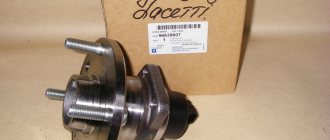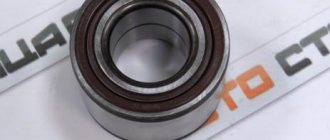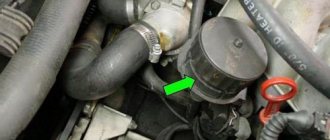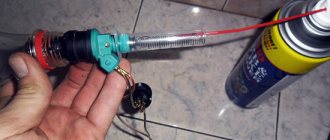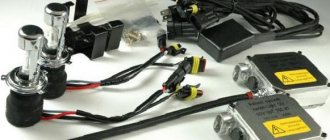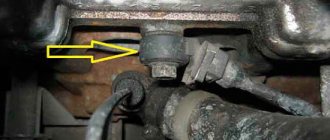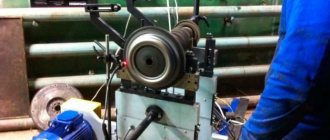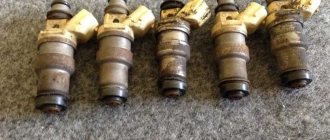Do-it-yourself replacement of the VAZ 2115 wheel bearing
Problems with the brake system or wheel bearing can be diagnosed by characteristic squeaks or knocking noises in the front (wheel area). If the brake system is in order, you will need to diagnose the wheel bearing and replace it if necessary.
To check the wheel bearing, you need to compare the temperature of the wheel rim at the end of a long trip on the side where the squeaks and knocks are coming from. If the disc is too hot, it means the pads are sticking or the wheel bearing is faulty. The latter can lead to wheel misalignment, which usually leads to friction.
Worth checking out:
- Algorithm for replacing the tie rod end of a VAZ 2114
To check everything more thoroughly, you need to use a lift or jack.
Raise the tire that is causing some doubt with a jack and rock its lower part, holding it with both hands. If you feel play and a dull knock appears, the wheel bearing needs to be replaced.
Also check out
- Remove the 2 bolts securing the ball joint to the lower control arm.
- Disconnect the lower suspension arm from the steering knuckle and move the lower cavity of the shock absorber strut to the side.
- Use a suitable extension to knock the hub out of the steering knuckle (it is better to use a special puller).
- Using special pliers, first remove the outer and then the inner retaining ring of the wheel bearing.
Recommendations:
Secure the steering knuckle to the lower control arm. So that it does not interfere, you need to connect it to the ball joint lever.
- Install the special key on the steering knuckle.
- Using pliers, install the outer retaining ring into the steering knuckle.
- We fix the puller with the new wheel bearing on the steering knuckle. To do this, you need to tighten the power nut of the puller, then press the bearing into the knuckle seat as far as possible.
- The hub is knocked out of the steering knuckle along with the inner bearing ring. That is why it is welcome to have a special puller with which you can remove the ring without much difficulty. If it is not there, you will have to use a grinder (this must be done especially carefully so as not to damage the hub).
- Place the hub on the puller and insert it into the steering knuckle. Place the puller against the inner wheel of the bearing, into which you want to press the hub.
You can also use a tool and a hammer instead of a puller.
- Using pliers, install the inner retaining ring.
Reassemble everything in reverse order. After replacing the VAZ 2115 wheel bearing, perform a wheel alignment.
List of new parts and tools for replacing them
Replacing the front wheel bearing on a VAZ 2114 begins with the purchase by the car owner of the following spare parts:
- front wheel bearing (original art. 11180 – 3103020 – 04);
- front hub retaining rings (usually included in the repair kit under art. 11180 – 3101800 – 86);
- a new front hub (art. 11180 - 3103012 - 00), which will be needed if there is excessive wear of the bearing and rotation in the seat.
It is possible to carry out all the work to eliminate this malfunction without damaging other suspension parts using the following set of tools:
- tire remover;
- set of open-end spanners from 12 mm to 24 mm;
- socket heads from 12 to 19 mm and wrenches;
- specialized wheel bearing puller;
- specialized steering wheel end remover;
- duckbills for removing retaining rings;
- carriage;
- Screwdriver Set;
- regular pliers.
The cost of work to eliminate this malfunction from official dealers (at the end of autumn 2022) ranges from 4 to 6 thousand rubles. In small private service workshops they will ask for work from 2500 to 3000 rubles. After reading the instructions below, carrying out repairs yourself will not cause big problems for the owner of a VAZ model 2113, 2114 or 2115.
Which bearing to choose
As a rule, tapered single-row roller-type bearings are found in the front hub. More complex mechanisms are most often used on front-wheel drive cars. Such bearings can withstand enormous loads, but their prices differ markedly. Closed-type hub bearings are easier to operate - during manufacturing they are filled with a lubricant and there will be no need for replacement. They are completely sealed and cannot be taken apart. Open roller bearings require constant maintenance. If you constantly monitor the condition of the bearings, then the front wheel bearings can easily last up to 130 thousand kilometers.
Required Tools
To complete the work, nothing unusual is required - most of the tools are already in the car enthusiast’s garage:
- pliers (with their help it will be necessary to dismantle the retaining rings);
- socket wrench. If you have the whole set, great, but for this work, number “30” is especially necessary;
- spanner wrench Again, you can use a set, but one “12” key is enough for the job. Without it, it will not be possible to remove the guide pins from the brake drum;
- special puller (necessary for pressing out bearings);
- Additional tools that may be useful are a hammer, a small wooden block, a pry bar and a chisel.
Bearing diagnostics
Let's talk about how to check a wheel bearing.
An indirect sign that you need to pay attention to the bearing on the VAZ 2114 is the appearance of a characteristic hum or hum from one of the wheels while driving. The noise usually increases at high speeds, making it easier to hear on the highway.
Diagnostics is carried out in the following way.
We raise the car so that the wheel being diagnosed is hanging out. We rock it with our hands, holding the top part. We turn the wheel by hand. Pay attention to the smooth deceleration of movement and to extraneous sounds. An emerging backlash may also indicate a problem.
Algorithm for replacing the VAZ 2115 wheel bearing
- Put the car on the handbrake, support the wheels with wheel chocks.
- Break off the mounting bolts.
Do-it-yourself replacement of the VAZ 2115 wheel bearing
- Jack up the wheel and hang it up.
- Using a 30mm wrench, remove the central nut securing the hub.
Do-it-yourself replacement of the VAZ 2115 wheel bearing
- Disconnect the drive shaft CV joint from the hub, remove the caliper and disc.
Do-it-yourself replacement of the VAZ 2115 wheel bearing
Front wheel bearing, where it is located and signs of malfunction
The front wheel bearings in a car are subject to extreme loads - high temperature changes, environmental influences, the formation of shock loads during driving into pits, jerks of the steering, brakes, and drive.
The play should not prevent the wheel from rotating; it is important that it rotates with minimal friction and noise allowed
However, despite the actually colossal loads, wheel bearings are durable and very strong. When braking and accelerating, increased pressure occurs on them, and during movement, not one, but several forces influence them.
Very often, vehicle owners remember about these parts only when excessive noise occurs when the wheels operate. The most common problems are improper operation or installation of the front wheel bearings.
The following signs will indicate problems with the front wheel bearings - a strong hum or noise, which is most noticeable when cornering, the appearance of play in the wheel, which is also accompanied by noise or knocking.
Who are packers?
Well, the guys have dealt with the monsters of the industry, but there are also so-called packagers - these are companies that do not have their own production facilities, but package “hubs” from third-party manufacturers. A small list of famous ones:
1) Ruville is one of the largest, but indiscriminate, it can pack both serious brands and outright fakes, mainly from Eastern Europe, Romania, Poland, etc.
2) Optimal – Polish packer, worked with IRB, SKF and FAG. However, now it has become an outsider, you can find fake China, Ukraine, etc. You need to look closely.
3) HK – used to belong to FAG, and accordingly only packaged its products, it’s worth taking a closer look.
4) QH - cheap Chinese brands, but not fakes. Medium quality.
5) Corteco - cheap brands are often from China, not worth buying.
Rear suspension and chassis design
Before proceeding directly to the replacement process, it is worth considering the rear suspension structure in order to understand the location of the part, as well as determine what needs to be removed in order to change the rear wheel bearing.
1. Rear wheel hub; 2. Rear suspension arm; 3. Suspension arm mounting bracket; 4. Rubber bushing for the lever hinge; 5. Lever joint spacer; 6. Rear suspension arm mounting bolt; 7. Body bracket; 8. Support washer for fastening the shock absorber rod; 9. Upper suspension spring support; 10. Spacer sleeve; 11. Suspension spring insulating gasket; 12. Rear suspension spring; 13. Shock absorber rod mounting pads; 14. Compression stroke buffer; 15. Shock absorber rod; 16. Shock absorber protective cover; 17. Lower support cup of the suspension spring; 18. Shock absorber; 19. Lever connector; 20. Hub axle: 21. Cap; 22. Wheel hub nut; 23. O-ring; 24. Bearing washer; 25. Wheel bearing; 26. Brake shield; 27. Retaining ring; 28. Mud deflector; 29. Suspension arm flange; 30. Shock absorber bushing; 31. Lever bracket with eye for mounting the shock absorber; 32. Rubber-metal hinge of the suspension arm;
Step by step replacement
1. Place the desired wheel on the jack and remove it.
2. Flare the hub nut.
3. Place the wheel and engage the gear. We take the head at thirty and tear off the hub nut.
4. Remove the wheel and completely unscrew the hub nut.
5. Unscrew the 2 bolts securing the brake caliper using a 17mm wrench.
The bolts are located at the rear of the caliper.
6. Separate the pads and remove the caliper. So as not to interfere, we tie it to the stand.
7. Unscrew the 2 bolts securing the brake disc and remove. Nuts for twelve.
8. Remove the 2 ball fastening bolts. Seventeen bolts.
After unscrewing the bolts, remove the ball pin from the hub.
9. Pull the hub towards you and remove the axle shaft from the hub.
10. Using pliers, remove the cotter pin and unscrew the nut securing the steering tip pin.
11. Using a puller, squeeze out the finger.
12. Turn the strut out and knock the hub out of the bearing. I took a nineteen head and used it as a guide. You can come up with something else.
13. Remove the retaining rings holding the bearing on both sides.
14. Install the puller and squeeze out the bearing. Instructions for using the puller are on the box.
The puller costs 1000 rubles.
15. We pick up and remove the boot from the hub.
16. Press out the bearing race that remains on the hub.
To make it easier to rotate, I placed the hub with the back side into the wheel. I aligned the holes and inserted a screwdriver to prevent it from turning.
17. Install the internal retaining ring.
18. Lubricate the bearing seat. This will make pressing easier.
19. We mount our bearing into the puller and press it in.
20. Install the external retaining ring.
21. Mount the hub boot.
22. We also press the hub into the bearing using a puller.
23. Putting everything back together. If you forgot what comes with what, watch the video.
Video lesson
If while driving your car you often hear a characteristic creaking or knocking sound in the front part, in the wheel area, this may indicate problems with the brake system or a failed wheel bearing. You can also find out how to replace it at
How to remove a bearing by removing the steering knuckle from a car, advantages and disadvantages
When removing the steering knuckle from the car, replacing the bearing is much simpler and more convenient, however, the camber adjustment of the vehicle can be disrupted. Before unscrewing the bolts that secure the steering knuckle to the strut, two marks should be placed. One mark marks the position to the adjusting bolt post, and the second mark marks the position to the steering knuckle post. During assembly, it is necessary to ensure that these marks match.
Even if the initial accuracy cannot be achieved, the error will be minimal. This method is well suited for drivers who not only change the front wheel bearing, but also carry out chassis repairs - replacing steering tips, lever silent blocks, ball joints, and so on.
How to change a bearing yourself
Before starting work, you should carefully study all its stages:
- We jack up the car from the side of the faulty bearing, remove the wheel and, having access to the lock nut of the outer CV joint, unscrew it using a 30 mm socket. It is worth considering that when subjected to high loads, the nut can be heavily tightened; in this case, the wheel is put in place, the car is released from the jack, after which we engage first or second gear in the gearbox and with great force and an elongated wrench, it can be torn off.
Next, we proceed to dismantling the brake cylinder, for which we need to unscrew the two bolts that secure it from the inside of the hub with a 17 mm wrench, and using a flat-head screwdriver, carefully pressing the pads away from the disc, we remove this unit to the side.
- We unscrew the nut securing the steering tip from the steering knuckle, and using a specialized puller, squeeze it out of its seat, then we perform a similar operation with the tip of the ball joint located at the bottom of the hub
- The upper part of the steering knuckle is attached to the suspension shock absorber strut with two bolts, the lower of which regulates the vehicle's wheel alignment, mark its position and, after unscrewing these bolts, remove the entire hub assembly. We also remove the brake disc secured with two screws.
- Using a specialized puller, we press the front hub out of the inner race of the bearing, then remove the retaining rings on both sides, and with the same puller, we squeeze the old bearing out of its seat.
- Before installing a new wheel bearing, we clean its seat from old contaminants, carefully inspect it for possible damage, small chips and cracks, and if they are found, the steering knuckle must be changed, otherwise there is a possibility of its rapid breakdown.
- We lubricate the bearing seat in the steering knuckle, which will greatly facilitate its pressing, install one retaining ring and mount the new part using a specialized puller until a characteristic click is heard, after which the second retaining ring is inserted.
- We clean, inspect for damage and, if there is none, lubricate the seat of the front hub. Then, using a puller, we carefully press it into the inside of the new bearing and mount the entire assembly into its seat. After that, we carefully insert the splined flange of the drive, install the brake disc, caliper, ball joint and steering end, after which we tighten the new nut securing the outer CV joint, which comes in the repair kit for new parts, roll its edges into the locking grooves and put the wheel in place.
This completes all work on replacing the front wheel bearing. Also watch the video for a detailed analysis of replacing the front wheel bearing on VAZ 2113, 2114, 2115 cars:
If while driving your car you often hear a characteristic creaking or knocking sound in the front part, in the wheel area, this may indicate problems with the brake system or a failed wheel bearing.
If the first option with the brakes is not confirmed, then most likely the wheel bearing will need to be replaced. To make sure the “diagnosis” is correct, perform a simple diagnosis.
To check the wheel bearing you do not need to have any special devices. To do this, it is enough to compare the temperature of the wheel rim after a long trip, from the side from which squeaks and knocks are heard. If the disc is very hot and cannot be touched, this indicates that the pads are seizing or the wheel bearing has failed. A faulty wheel bearing causes the wheel to become misaligned, causing friction.
A more accurate check is made using a lift or jack.
Jack up the suspect wheel, then grab the bottom of it with both hands and rock it slightly. If, when rocking, you feel play and hear a dull knock, this will mean that the hub bearing needs to be replaced.
Today we’ll talk about how to replace a VAZ 2115 wheel bearing with your own hands, but before that, a few words about the tool.
You will need:
- “30” wrench for unscrewing the central hub nut;
- Puller for pressing out/pressing in the wheel bearing;
- Circlip pliers (or pliers);
- Jack.
How are alloy wheels tightened?
To perform such a scrupulous procedure, a special tool is used - a torque wrench. Mechanics also use pneumatic impact wrenches at service stations. And at home, drivers use a wheel wrench.
First of all, you should pay attention to the diameter of the wheel, its width, and then to the design
The number of holes along the rim is also important. They must necessarily have cone-shaped recesses, which are necessary for centering the disk on the hub with bolts and nuts
The number of such holes can be different - from 4 to 6. Some models have more than six
They must necessarily have cone-shaped recesses, which are necessary for centering the disk on the hub with bolts and nuts. The number of such holes can be different - from 4 to 6. Some models have more than six.
For different types of alloy wheels, the tightening of wheel fasteners is not the same. It differs in the sequence of actions. So, rims with 4 holes must be installed in the order 1-3-4-2, and rims with five bolts are secured in the order 1-4-2-5-3, but for rims with six nuts the option 1-4-5 is suitable -2-3-6.
Causes of wheel bearing failure
It is also important to note that if the hub fails, it becomes very hot. As a result, the brake system fails, and therefore operation is disrupted
However, the work is never disrupted at the same time, unless there is a strong collision with another object. The car may hit a hole, a bump, or drive onto a curb. As a result, the VAZ 2114 may receive serious mechanical damage.
Destruction occurs gradually and the driver can often understand this by the presence of a specific sound when a specific body vibration appears. There may be small shocks, sometimes the car shakes.
There are several reasons why a malfunction may occur:
- Constant driving on off-road or poor quality roads with a lot of uneven surfaces.
- Transportation of large loads.
- The car may constantly fall into mud or slush.
- Some drivers begin to drive aggressively: they brake or accelerate sharply, or drift.
Depending on what cause is present, deformation of the main housing may occur over time, and sometimes the outer housing and bearing rim may crack. Often the lubricant dries out. Dirt, sand, and dust may get inside the rotating parts.
Sometimes there is a malfunction of the rollers and bearing balls. Often this happens not as a result of inaccurate driving, but from the quality of workmanship itself. Spare parts from domestic or European manufacturers last an order of magnitude longer than from Chinese ones. But they can also become unusable over time as a result of constant use of the car.
When a breakdown just begins to appear, it is almost impossible to recognize it in a timely manner. As a rule, for this purpose you need special diagnostic equipment, which is available in auto repair shops or official dealers. If a whistle, strong hum or crunching occurs, you have to provide it yourself or with professional help.
If the breakdown occurs on the front hub, then identifying the fault is much easier. It is enough to pick up a speed of 40-60 km/h and perform simple maneuvers. Most often, a specific hum appears. If the sound increases when turning to the right, this means that the left bearing has failed. The opposite situation occurs with the left side.
If a breakdown occurs in the rear hub, it is much more difficult. So, for example, the sound may come from one part, but in reality the breakdown may be localized in a completely different place.
However, experts advise that in order not to engage in self-repair in vain, it is recommended to carry out diagnostic measures from professionals. If the car enthusiast does not have the relevant experience, then you can ask the person to show how to carry out such events.
